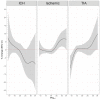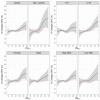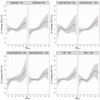Particulate Air Pollution Exposure and Stroke among Adults in Israel
- PMID: 36674236
- PMCID: PMC9860673
- DOI: 10.3390/ijerph20021482
Particulate Air Pollution Exposure and Stroke among Adults in Israel
Abstract
Stroke is the second most common cause of death and disability in the world. Many studies have found fine particulate matter (PM2.5) exposure to be associated with an increased risk of atherosclerotic cardiovascular disease, mostly focusing on ischemic heart disease and acute myocardial infarction. In a national analysis conducted in Israel-an area with unique climate conditions and high air pollution levels, we estimated the association between short-term PM2.5 exposure and ischemic stroke, intracerebral hemorrhage (ICH), or transient ischemic attacks (TIA). Using the Israeli National Stroke Registry, we obtained information on all stroke cases across Israel in 2014-2018. We obtained daily PM2.5 exposures from spatiotemporally resolved exposure models. We restricted the analytical data to days in which PM2.5 levels did not exceed the Israeli 24 h standard (37.5 µg/m3). We repeated the analysis with a stratification by sociodemographic characteristics and comorbidities. For all outcomes, the exposure-response curves were nonlinear. PM2.5 exposure was associated with a higher ischemic stroke risk, with larger effect estimates at higher exposure levels. Although nonsignificant, the exposure-response curve for TIA was similar. The associations with ICH were nonsignificant throughout the PM2.5 exposure distribution. The associations with ischemic stroke/TIA were larger among women, non-Jewish individuals, older adults, and individuals with diabetes, hypertension, and ischemic heart disease. In conclusion, short-term PM2.5 exposure is associated with a higher risk for ischemic stroke and possibly TIA, even when PM2.5 concentrations do not exceed the Israeli air quality guideline threshold. Vulnerability to the air pollution effects differed by age, sex, ethnicity, and comorbidities.
Keywords: PM2.5; air pollution; stroke.
Conflict of interest statement
The authors declare no conflict of interest.
Figures



References
Publication types
MeSH terms
Substances
Grants and funding
LinkOut - more resources
Full Text Sources
Medical

